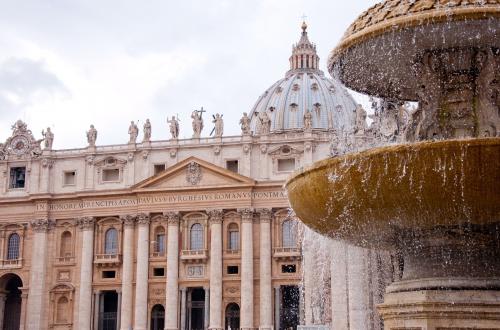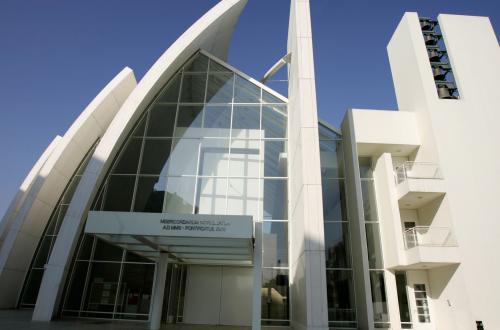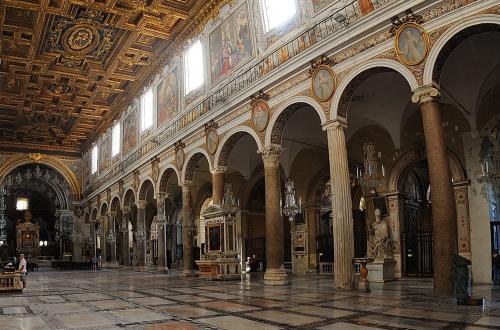Basílica de San Pedro en el Vaticano

 Condividi
Condividi
The basilica of St Balbina in Rome is an early Christian cult building, located on the little Aventine in the district of San Saba.
The railway chapel is a meeting place to pray and celebrate the sacraments, and offers opportunities for dialogue to get to know and deepen the Christian faith.
The building was built in 1818 by Monsignor Nicola Nicolai for the peasants of his country estate, on the 'Via Paradisi' travelled in the Visits of the Seven Churches.
The Rome Baptist Church building is located in a palazzo in Piazza San Lorenzo in Lucina that was once part of Palazzo Ruspoli, originally built in the 16th century.
The parish was erected on 13 July 1950 by decree of Cardinal Vicar Francesco Marchetti Selvaggiani Universo gregi and entrusted to the diocesan clergy of Rome. The church was consecrated by H.E.
[...]It was built to a design by the architect Costantino Forleo and the engineer Raffaele Boccuni in the years 1956 - 1958 and consecrated by Cardinal Luigi Traglia on 27 May 1965.
The parish was erected on 5 November 1971 by decree of Cardinal Vicar Angelo Dell'Acqua Neminem fugit and entrusted to the diocesan clergy of Rome.
This tiny church is one of the smallest in Rome, and is the regional church for natives of the city and region of Norcia living in Rome.
It was built between 1996 and 1997 by architect Bozzini from Milan, who won a European competition announced by the Vicariate of Rome.
The church was designed by the architect Giuliano Panieri and built between 2007 and 2010The parish complex is here understood as a unique, articulated and functionally diversified complex that is
[...]The church is the seat of the parish of the same name, established on June 27, 1942 by decree of the Cardinal Vicar Francesco Marchetti Selvaggiani In and region: it was established to commemorate
[...]The parish complex of SS.
Santi Gioacchino ed Anna ai Monti (Saints Joachim and Anne on the Hills) is a church on the Via Monte Polacco in Rome.
In 1575, the community of Bolognese residents in Rome established a Confraternity to assist their fellow citizens.
Around the end of C. XVIII Luigi de León founded the Order of the Agostiniani Scalzi Spagnoli in Spain. In 1619 the latter created a hospice in Rome who was then annexed to the oratory in 1652.
[...]Santi Marcellino e Pietro al Laterano is a Roman catholic parish and titular church in Rome on the Via Merulana.
This is the church attached to the hospital with the same name, built between 1726 at 1729 by Benedict XIII through architect Filippo Raguzzini, who also designed the hospital, built for treating t
[...]The origin of the church of St Michael and St Magnus, perched on the southern edge of the Janiculum Hill, are extremely ancient.
The church, built to plans by architect Francesco Fornari, completed and consecrated in 1968, is the seat of the parish of the same name, established on 19 May 1954 by decree of Cardinal Vicar Clem
[...]Santi Simone e Giuda Taddeo a Torre Angela is a modern parish church and a titular church that can be assigned to cardinal priests in the papal diocese of Rome.The church is dedicated to Saints Sim
[...]Since ancient times, the cliffs that extend along the right bank of the Tiber from the Crescenza ditch to the Prima Porta ditch were called Saxa Rubra, due to the reddish color of the tuff outcrops
[...]The consecration of the church took place in 1221 by Pope Honorius III: the plaque commemorating the event is visible on the wall of the left aisle.
The church occupies part of a piece of land, now between Via del Corso, Via Gesù e Maria, Via del Babuino and Via San Giacomo, on which, in the early 17th century, stood a villa with garden owned b
[...]The parish was erected on 22 October 1957 by decree of Cardinal Vicar Clemente Micara Etsi antistitem and entrusted to the diocesan clergy of Rome.
The Church of the Sacred Heart of Jesus is located in Rome, in the Sallustiano district, in Via Piave at number 5.
It is located in the Bravetta district that is part of the Gianicolense district.
The Holy Name of Mary is a Roman parish run by the Marianist Fathers. The Society of Mary was founded by Blessed William Joseph Chaminade.
It was built in the 1970s based on a design by architects Ennio Canino and Viviana Rizzi, and inaugurated on March 6, 1977.

 Condividi
Condividi

 Condividi
Condividi

 Condividi
Condividi

 Condividi
Condividi